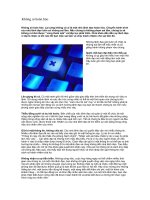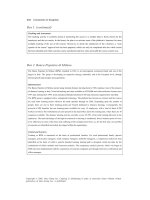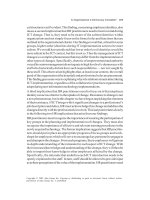Tài liệu E-Human Resource Management 26 doc
Bạn đang xem bản rút gọn của tài liệu. Xem và tải ngay bản đầy đủ của tài liệu tại đây (668.6 KB, 9 trang )
Is Organizational e-Democracy Inevitable? 211
Copyright © 2005, Idea Group Inc. Copying or distributing in print or electronic forms without written
permission of Idea Group Inc. is prohibited.
environment has focused attention on the role of ICTs and their ability to
disseminate information. The emergence of a knowledge economy, where
effective information transfer and the decentralization of organizational power
structures is paramount, however, raises questions about the nature of organi-
zational democracy.
Despite its prominence in change research (e.g., Beer & Nohria, 2000),
organizational democracy within the knowledge economy is confusing. In the
contemporary workplace, knowledge is regularly portrayed as the primary
resource for individuals (Drucker, 1992). The simultaneous sharing of informa-
tion through sophisticated technology is viewed as a primary tool of organiza-
tion (Orlikowski & Iacono, 2001). This process assumes that the militaristic
conditions of the industrial organization are antiquated and perhaps even
unnecessary. Consequently, changes to traditional bases of power and influ-
ence are believed to occur through decentralization and information access
(e.g., Applegate, 1994; Halal, 1996). Change initiated in the knowledge
economy is regularly presented as a constant feature of the modern organiza-
tion, despite the dissatisfaction that exists with the nature of change research
(see Tsoukas & Chia, 2002). This perspective that change is constant in the
knowledge economy adds a paradoxical tangent to organizational e-democ-
racy.
These changes do not necessarily foster democracy (Mantovani, 1994), even
though there are implied benefits of the evolving, boundary-less, and pluralistic
nature of organizations in the current global economy. Many organizations are
still organized autocratically (Kraemer & Dedrick, 1997; Schwarz, 2002).
Corporate ownership structures, governance systems, and incentive programs
are still firmly entrenched in the industrial age. Organizations are still primarily
organized through small management groups typical of hierarchies (Markus,
1983; Robey & Boudreau, 1999). Any features of employee empowerment
are limited.
It would, of course, be negligent not to recognize the advances made in the use
of more democratic governance methods, such as participatory management
practices (e.g., Drehmer, Belohlav, & Coye, 2000), organizational citizenship
(e.g., Lambert, 2000), and communities of practice (e.g., Wenger, 1999).
Nonetheless, change research is often too concerned with two aspects of
change. First, the research concerns itself with re-evaluating the authority,
power, and control features that normally exist in institutions (Scott, 2001).
Second, it concerns itself with the promotion of alternative organizational
designs and practices (Schilling & Steensma, 2001).
212 Watson, Schwarz, & Jones
Copyright © 2005, Idea Group Inc. Copying or distributing in print or electronic forms without written
permission of Idea Group Inc. is prohibited.
Organizational change in a knowledge economy context is regularly hypoth-
esized to bring about a more democratic organizational shape than previously
existed. For example, we expect more information connectivity and freer
communication than before. We expect more autonomy, but less centralization
and less hierarchy than before. Yet there is enough research, and a growing line
of argument, to undermine this assumption. Is organizational democracy in the
knowledge economy (i.e., e-democracy) inevitable? If organizations change,
then logically, so too must employee perceptions of their role in the organiza-
tion. In a consideration of the objectives of this chapter, we therefore invoke
social identity theory (SIT) as a guiding framework that may help understand
the outcomes from change and whether or not e-democracy emerges as a result
of ICTs.
Social Identity Theory and its Organizational Context
In the section that follows, we provide a preliminary overview of the theory,
referring readers to Hogg and Terry (2001, 2000) for a comprehensive review
of the theory and its links to organizational contexts. Social identification “is the
perception of oneness with or belongingness to some human aggregate”
(Ashforth & Mael, 1989, p. 21), encompassing salient group classifications.
Social identity theory, therefore, is based on the premise that most often it is our
group-based identities that are important in our interactions with others.
The central tenet of this approach is that belonging to a group is largely a
psychological state. This grouping confers social identity, or a shared represen-
tation of who one is and how one should behave (Hogg & Abrams, 1988). In
this way, group belongingness reduces our uncertainty about where we fit in
society (Hogg & Mullin, 1999). More recently, SIT has been applied to the
organizational context. Implicit in this understanding of organizational identity
function is the recognition that organizations are composed of the people in that
organization. In essence then, “Organizations are internally structured groups,
which are located in complex networks of intergroup relations that are
characterized by power, status, and prestige differentials” (Hogg & Terry,
2001, p.1). As a result, organizations are implicitly dynamic, continually
changing entities. Changes that affect the organization can therefore have
serious effects on employees in terms of their identification with workgroups
and the relationships between workgroups.
Is Organizational e-Democracy Inevitable? 213
Copyright © 2005, Idea Group Inc. Copying or distributing in print or electronic forms without written
permission of Idea Group Inc. is prohibited.
While there has been a longstanding research tradition examining organizational
identification, more recently SIT researchers have viewed organizations as
being composed of individuals possessing multiple group identities. These
identities range from the employees’ overall identification as members of an
organization, to their identification with specific work units and professions. At
any one time different group membership may be salient for an employee.
Accordingly, when a manager interacts with a subordinate, he or she is likely
to identify with their respective roles of manager and subordinate as most salient
in the work situation (Gardner & Jones, 1999). Yet in another context the
person’s professional identity may be most salient.
SIT has been used by organizational scholars to better understand how the
individual relates to these collectives, and the intergroup relations that accom-
pany the process of identification (see Pratt, 2001, for a comprehensive review
of this trend). Such a perspective does not deny the importance of an
individual’s personal identification, but sees it as often less relevant than group
identification in the workplace.
Social identity theory proposes that individuals will tend to make favorable
evaluations about their in-group (‘us’), but make unfavorable evaluations
concerning the out-group (‘them’). If we identify at the organizational level, we
perceive all employees of our organization as in-group members and employ-
ees of competing organizations as members of an out-group. More often
though, it is at the sub-organizational level that we make the most relevant
comparisons. The result is that employees will then tend to favor their
workgroup or department and evaluate it more positively than other workgroups
or departments. Organizational change, including the development of the
knowledge economy, may not only lead to the formation of new identities, but
may challenge/threaten existing identities and intergroup relations. Thus merg-
ers, acquisitions, and downsizing have increasingly become the subject of
research examining organizational change and SIT (Terry, 2001; van
Knippenberg & van Leeuwen, 2001).
Such research has been crucial in understanding change from an SIT perspec-
tive, but as Hogg and Terry (2000) note, they do not address important
developments of SIT in the last decade that are particularly relevant as to
whether e-democracy may emerge in response to ICTs. Recent developments
include research on identification problems dealing with (1) loyalty, and (2)
nested and cross-cutting identities. Looking first at the issue of loyalty, as
information intensity becomes more relevant to organizational functioning,
many of the traditional roles of identity are undercut (Neef, 1998). Group
214 Watson, Schwarz, & Jones
Copyright © 2005, Idea Group Inc. Copying or distributing in print or electronic forms without written
permission of Idea Group Inc. is prohibited.
identification is a process whereby individuals become connected with others
and where joint interests may overtake those of the individual. When there are
changes in perceived membership or competing identities emerge which make
the lines of group belongingness unclear, questions concerning group loyalty
may arise. Specifically, employees ask whether their loyalty should be con-
ferred to the group, the organization, the professional association, the occupa-
tion, or to workmates?
Thus, before individuals can act in a given organizational context, they need to
situate themselves, allowing certain identities to be nested or embedded within
others (Ashforth & Johnson, 2001). Nested identities exist at the higher order
level, such as an employee’s identification with his or her division, which is
nested under the organizational identification. Lower order identities are those
of identification with an individual’s job. Job identification would be nested
under an individual’s workgroup. Conversely, cross-cutting identities refer to
an employee’s committee or task force identification that runs across the
hierarchical structure. Cross-cutting identities and lower order level nested
identities are more likely, more salient, and more proximal than are higher order
level identities (see Ashforth & Johnson, 2001, for a full discussion on this
topic). Internal conflicts may arise when an individual perceives competing
demands across two of his or her work identities. The cognitions and identity
changes that occur during change therefore need to be thoroughly investigated
in order to better understand the change outcomes.
The longitudinal study that we present in this chapter acknowledges these
aforementioned complexities and seeks to raise awareness levels of HR
managers to these issues. Specifically, we contend that an examination of any
change implementation without due consideration to the psychological pro-
cesses that underlie an employee’s perception of the change will not provide an
accurate picture of the evolution process during change. Nor will such an
examination provide an understanding of the potential subsequent changes in e-
democracy.
The empirical review that follows describes how employee workgroup identi-
fication interacts with technology change and communication effectiveness, and
the outcomes in terms of e-democracy. Employee responses include percep-
tions about changes to their levels of job satisfaction and commitment, as well
as changes to the status and prestige of their workgroup and other groups within
the organization. For HR practitioners, these are important considerations that,
if managed well, allow for smooth transitions during change. Researchers have
typically neglected the intergroup nature of change, despite the fact that
Is Organizational e-Democracy Inevitable? 215
Copyright © 2005, Idea Group Inc. Copying or distributing in print or electronic forms without written
permission of Idea Group Inc. is prohibited.
corporate change involves major reallocations of status, power, and resources
across divisions of an organization (Gardner, Paulsen, Gallois, Callan, &
Monaghan, 2000).
We present change as a process that impacts on an organization in at least two
ways. First, there is the individual impact upon employees in terms of their levels
of job satisfaction and organizational commitment. Second, researchers — and
by implication, HR practitioners — need to consider the significant impacts
upon employees’ levels of identification with their workgroups or the social
categories with which they identify. This second impact is demonstrated by
employees’ perceptions of changes in the groups they identify with, perceived
status, and the levels of in- and out-group bias.
Our approach adds to previous research by considering whether e-democracy
is an inevitable consequence of ICT changes, and how a social identity
perspective helps us understand the effects of ICT changes. We argue that
social identity theory provides an alternative (socially) evaluative insight into the
nature of change and the process of how organizations evolve and adapt to the
knowledge environment economy. In this chapter, we concentrate on how
group memberships within organizations are influenced by change. Our ap-
proach differs from other researchers who have applied democracy at the
organizational level in debating what the organization and organizational change
will look like (e.g., Lammers & Szell, 1989; Mason, 1982).
Social identity argues that organizations are internally structured groups that are
located in complex networks of intergroup relations characterized by power
and status (Hogg & Terry, 2000). In referring to the processes that underlie the
development and maintenance of individual and group identities, social identity
allows us to better deconstruct the process of organizational democracy using
this prestige differential.
As part of this examination, we discuss change and organizational democracy
by focusing on how the social identity of health professionals in a large
metropolitan hospital affects their understanding of and adaptation to new
ICTs. Our analysis was guided by two research questions:
RQ1: What is the relationship between employees’ perceptions of their
workplace identification and e-democracy change?









